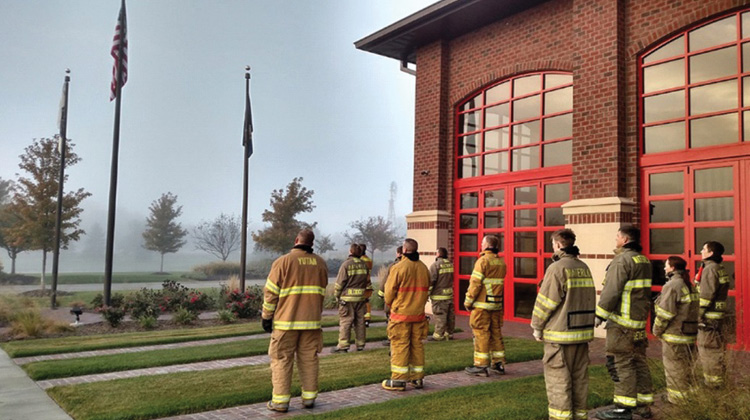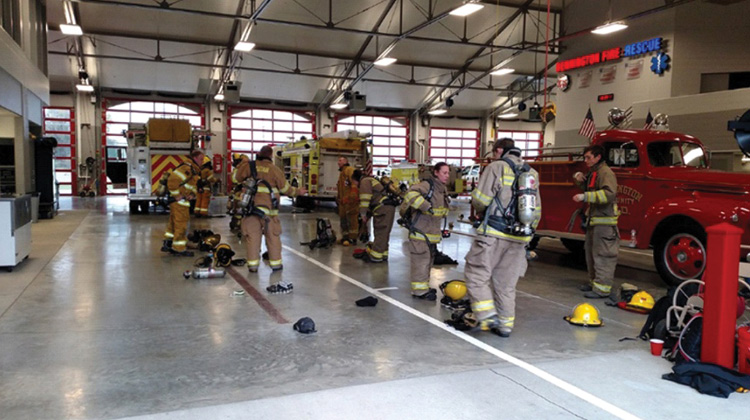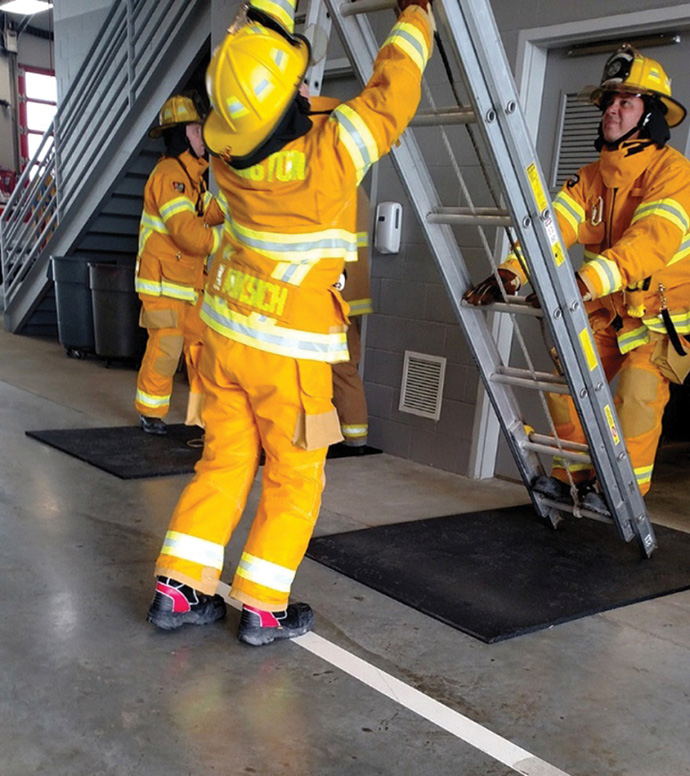
VOLUNTEERS CORNER ❘ By DAN MILLER
As firefighters, most of us can identify with wanting to be on a select team, not just the “B” or scout team. If you sign up to join a volunteer fire department, there is at least some expectation that it will be physically demanding, enthralling, and life affirming and bring you some type of personal change that you’ve been seeking.
Those who sign up to be on a volunteer fire department want to be a part of something bigger. This typically involves wanting to be a part of a group—a fraternity, if you will. Perhaps they had role-model relatives or friends who were or are members or who outright encouraged membership based on their positive experiences as volunteer firefighters. In any case, being a firefighter is a calling that takes you to a “next-level” experience, if you accept it.
Probationary Models
Most volunteer firefighter recruit indoctrination (probationary) period models may resemble the following:
- Sign up to become a firefighter; get voted on; receive a key and a pager; and start showing up to training, meetings, calls, fundraisers, and so on. There is no set acceptance or indoctrination period. Certification training is often available as desired, but it is not required. This model may take years before a member demonstrates qualification and belonging and is fully accepted as a team member (other than on paper). This process is open ended and ambiguous to the new member, sometimes on purpose.
- Applicants are tentatively accepted by a vote, which begins a defined probationary process of six to 18 months, during which time the members undergo initial training and are expected to attend meetings, drills, and activities. However, they will also respond to emergency calls as soon as they are issued personal protective equipment (PPE) through an internal process. This process may be undocumented or based on a task or training list of internal origin. The members are encouraged to receive certification training as emergency medical technicians or firefighters within the first one to three years. This puts some expectations on the new members, but it leaves them without validated and performance- and certification-based training while still answering calls in potentially life-threatening circumstances, with little or no decision-making model or validated background education.
- Following the vote, the new members are sent immediately to a certification course in a third-party location using third-party equipment. They then come back with a piece of paper saying they are certified firefighters. Although they are in class, they are expected to do little in the way of participation with the department. When they return, some combination of examples 1 and 2 takes place. In this model, the members may have been indoctrinated (partially, at least) to an ambiguous fire department model while in class. If there is no intense follow-up to bring these members up to local expectations and acceptance, they can feel very left out. They can also assume some hometown procedures aren’t up to snuff with what they just learned in class. There is a disconnect that must be mended but that, often, is not.

(1) Candidates recite the Pledge of Allegiance daily at the beginning of class. (Photos by author.)
As the years go by and leadership changes, the previous model’s processes are often intermingled, depending on who is in charge and how badly new members are needed. For recruit members involved in a process such as those in the three previous examples, there is typically dissatisfaction on the part of the probationary members, the department, and the members’ families. None of those models contain acceptance, indoctrination, and baseline expected certification training. In many cases, it takes three to five years for a volunteer firefighter to gain all three. This is a long time to wait and, frequently, results in attrition of new members. More than anything, new members are disillusioned by being undertrained and underused. It results in new members leaving for something more connected and fulfilling, with higher expectations and faster results.
The fire department is left with a partial member until he is accepted, indoctrinated, and trained to some certification-based level that is acceptable to the other members and citizens. The citizens are paying for and supporting the operation, and they expect certified, capable, high-performance teams of experts to show up and solve their problem when they call 911, whether paid or not. They have a right to some expectations. Being firefighters and members of an elite team, most of us want to meet or exceed public expectations and are constantly striving to do so.
Fire departments spend in the range of $8,000-10,000 to outfit, equip, and train each new volunteer member. So, how do volunteer fire departments get better, faster, performance results from new members while leaving that new member with a sense of intense belonging, accomplishment, and connection? The solution contained within doesn’t come easy.

(2) Recruits drill on donning personal protective equipment, first for accuracy, then for time.
An Opportunity for Change
Over many years as a part-time state fire instructor, volunteer fire officer, and career firefighter and instructor, I was brought into the paradigm of being kinder and gentler to the volunteer firefighter rookies. After all, they are precious, and we don’t want to lose them. They are generally in short supply. What this resulted in was a generation of “mashed potatoes”: low expectation, poor performing, half-committed, undertrained members. Meanwhile, senior members complained about declining membership and the lack of adequate numbers of trained personnel. I never believed this narrative myself, but I have been constantly bombarded with it, even to this day. For years, I was looking for a way to break that cycle of self-defeat.
RELATED
Rapid Reps at the Recruit Academy
The Fire Academy Instructor: Characteristics of a Good Educator
Assessing Character in Fire Academy Recruits
Then, along came my position in the training division of a large metropolitan fire department. In this position, running the career firefighter academy, my fellow team members and I saw signs of the same affliction and mindset in our career members: low performance, dissatisfaction, lack of indoctrination and acceptance, and even some attrition. We had high expectations, but we weren’t delivering courses that were highly physically and technically challenging.
It was our team’s chance to change the outcome. We immediately set out to return to highly challenging daily physical expectations of years past but with more science behind the controlled chaos and a connection to high-level firefighting skills, team mindset, and mental fortitude development. We didn’t make training and certification easier; we made it harder. We took a Navy Seal approach to changing physical aspects of the academy and, as a result, the internal survival beliefs of each recruit firefighter.
It worked. The results were relatively quick and sustained over a three-year period, with more than 100 new career members trained to the new expectations. The satisfaction among the recruits was high as well as the field training officers who received these candidates following the academy.
The “Volunteer Academy”
While looking for a way to transfer this success to volunteer firefighter certification courses, I came up with a general methodology that has been successful: the “volunteer academy.” This volunteer academy has reduced attrition, sped up adoption of department culture, developed members into street-ready and trustworthy certified firefighters much sooner than traditional models, and filtered applicants who were not ready to be fully involved. The process involves the following steps:
- Accept applications over a period of time, but hold applications until you are ready to begin a new academy class for a group (preferably six or more rookies) or conduct a short-term membership drive and be prepared to start training that group as soon as the membership drive is complete. If necessary, work with a neighboring department and conduct a joint academy, agreeing on common rules. The rules that the recruits have to follow MUST be rock solid. It is also vital to set a start date prior to accepting the applications (the quickest way to disappoint and disillusion a new applicant is to be wishy-washy on a start date). Let them know you are a legit program by sticking to your calendar.
- Establish who the lead instructor is or, if necessary, hire one. The lead instructor must be certified to the level he is teaching as well as Instructor I and must work with the state agency to coordinate curriculum and documentation. The lead will spend the most time with the recruits and become the face of stability and trust. Address all rules up front, and then give the lead instructor the reins. He must have complete authority to enforce the rules within a legal and reasonable framework of fair play to be spelled out in advance. If recruits believe that the instructor does not have complete authority to remove them from class, set rules, or provide discipline, they will push the boundaries. It is extremely important to have a lead instructor with a flawless record of fair treatment of all. If there is a question regarding this, don’t use him. If the recruits question the stability of the lead instructor or your trust in him, the rules go out the window and so does the reputation of your program.
- Complete all preliminary medical clearances and PPE checkouts in advance of the first class session. All recruits must be 100 percent ready to participate in PPE training on the first minute of day one.
- Establish standard operating procedures, house rules, uniform rules, before- and after-class cleanup duties, and expectations of assisting instructors. Also establish a rule with the host organization that lets everyone know that the academy participants will be under the control of the academy instructors and that participants will be told to courteously address current members and officers only as necessary and only by their titles and last names. As a show of respect, recruits will be expected to stand aside when meeting current members and officers in common areas and to stand when any nonclass member or officer enters the classroom.
- On day one, assemble the members in the agreed-on uniform and in military formation (explain exactly how you want them to look each time so they know). This will be their first inspection. Go student by student and address hygiene and safety issues such as jewelry, facial hair standards, long hair, how to wear the uniform, and so on. Stick to the rules. If you give an inch, they will disrespect you. A work uniform (i.e., a department T-shirt, pants, and footwear) is usually adequate for hands-on training. Do NOT accept inadequate footwear. Many injuries occur when preparing or cleaning up because of improper footwear. One of the major goals here is to build identity as a firefighter and team member as well as professionalism. Additionally, to build pride in the uniform, the instructor must be diligent about his own uniform, cleanliness, readiness, hygiene, and so on. Discuss this with assistants ahead of time.
- Establish a ritual such as saying the Pledge of Allegiance in formation at the beginning of each class. Build good citizens and firefighters. It’s up to us. These are usually young people who don’t necessarily know what it means. By the end of the academy, they will take great pride in saying the Pledge with their fellow firefighters and will proudly pass on this tradition.
- Establish a daily and weekly routine for recruits to follow. For example: Be ready 15 minutes before class starts. Have all PPE and self-contained breathing apparatus checks complete prior to class start. Don’t be the one who holds up class, or you will be disciplined. As the academy progresses, lump in additional responsibilities for equipment and apparatus checks after you teach the students how. Checking apparatus and equipment before every class is an opportunity to provide training on policy, know what to do with broken equipment, and establish “expectations” for acceptable work habits. At the end of every session, expect recruits to leave the station and equipment better than they found it; this is how good members are “built.” Provide such expectations in writing at the beginning of the academy.
- As the course progresses, proceed through the Firefighter I, Hazmat Operations, National Incident Management System (NIMS), and basic life support (BLS) curricula as required. Provide adequate time for chapter reviews in class, but expect the recruits to study on their own time. Use slide presentations for review only, until you get to the technical material. Spend approximately 70 percent of your time with students doing hands-on training in this hands-on job.
- As the course progresses, “turn up the heat” in new areas while acknowledging their progress in other areas, and then move on. Maintain decorum and discipline throughout. Expect high performance, but work with members who struggle. Often, people with learning disabilities or a total lack of knowledge of mechanical equipment will turn out to be your best members. This is your job as an instructor.

(3) Seventy percent of the class time should be hands-on skills practice.
Your goal is to appear as though you use this academy process every time. Avoid letting anyone feel that this is the first time you have done it. Also avoid letting any current members get in the heads of the rookies. Avoid letting current members start training rookies. If rookies have previous training, let them know that this represents a fresh start with new rules and that they are to participate fully with the instructor or risk removal from class. If they question procedures because they learned differently in previous training, they can address it with the instructor/staff respectfully following class.
Don’t be afraid to let go people who aren’t ready to fully commit. If they have a valid reason, other than just something that can be coached away, focus on the ones who stay. Build a select team, not a “junior varsity” one. With the volunteer academy approach, I have lost 10 percent of the recruits within the first two weeks, but then I seldom lose another. This is a good thing; those 10 percent are likely preoccupied with life-consuming priorities that will prevent them from being successful, and they know it. Practically speaking, this is usually before you have spent a lot of money on new fitted PPE and other expensive items for them.
In comparison to the old method of teaching firefighter certification courses in a less demanding, presentation-heavy class, without tough expectations and behaviors, over a four-to six–month period, the results are faster, better, and more satisfying for all involved. With the old method, the attrition rate during a Firefighter I class was often as high as 30 to 35 percent.
The benefit to the department and the taxpayers comes in the form of return on investment. Within four months of their start date, recruit members are certified to Firefighter I, Hazardous Materials Operations, NIMS 700, and BLS per National Fire Protection (NFPA) 1001, Standard for Fire Fighter Professional Qualifications. With supervision, they will become very useful on scene within a short time. It is short and intense, and the department will have most of the answers it needs about the probationary member. At this point, the newly certified members can begin responding to calls. It is the “carrot and the stick” method—no calls until certified. Again, this is a hard and fast rule to experience success.
Last, throw a graduation party. The intensity of the experience at an academy is celebrated by a graduation party where family and friends can share in the success of their loved ones. A graduation party facilitates the buy-in of the members’ families to the sacrifices that they have made and will make for years to come.
In academy-style firefighter training, students not only are introduced to NFPA standards, objectives, and job performance requirements but also the concepts of honor, pride, and commitment are instilled and constantly evaluated. The mind and body are trained to work together to perform essential firefighter skills without fail. The results are brotherhood, respect for rank and seniority, excellent skill performance, and a high level of commitment to the department. It’s not just a class; it’s an experience.
DAN MILLER is a 37-year fire service veteran and the chief of the Columbus (NE) Fire Department. He was previously a battalion chief (ret.) and academy commander for the Omaha (NE) Fire Department. Miller also retired as a part-time instructor for the Nebraska State Fire Marshal Training Division. He is CEO of Training Under Fire, LLC.

